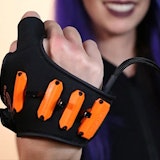
Complete with 2G and 3G reception, the Samsung Gear S can make calls and send messages just like your phone. It’s also the first full smartwatch to boast a curved display, adding a suitably futuristic look to match its wrist-phone functionality.
The idea of ditching your phone and using only a watch is a novel one. It would certainly free you up from the addictive distractions of your ever-present entertainment device. There’s something attractive about the idea of using new technology to hark back to a time of simpler functionality.
Could you really ditch your phone?

It’s certainly possible, given a good enough user interface (UI) and sufficient voice-recognition, to rely on a watch for general communication. After all, plenty of people still get by with feature phones, which are generally restricted to SMS and Voice.
The Gear S can do both of those things. Making calls is easy. Unless you have a Bluetooth headset you’ll be restricted to listening to the conversation on speaker, but placing and receiving the call would be no issue.
Texts are a little trickier. It’s a simple enough matter to read a text on a smartwatch, but replying has always been the issue. Voice-input is inappropriate or unusable in many situations, and an on-screen keyboard would be a tricky thing to manoeuvre. Whether or not Samsung has pulled this off is going to be an important factor in just how usable as a communication device the Gear S really is.
But could it replace a smartphone?

No. Not yet, anyway. Certainly there are plenty of applications that could be adjusted for a smaller screen. Facebook has apparently already jumped on board the Tizen app store, which is already one thousand apps strong.
There's also S-Voice tie-ins for planning and calendar use, as well as turn-by turn navigation and a built-in GPS system.

Be that as it may, the limitations of a 2-inch display are numerous as they are obvious. Navigating the web, playing games and reading books would all be basically impossible.
Moreover the tiny 4GB of on-board storage and lack of decent camera would be deal-breaker for a lot of people.
Application denial

Like the Galaxy Gear 2 before it, the Gear S comes running Samsung’s own Tizen operating system (OS). Unlike an Android Wear device, Tizen requires developers to make a separate Tizen-specific version of their apps if they’re to run at all. This was a huge problem with the Gear 2, where functionality was crippled by the meagre number of available applications.
A perusal of the Tizen app store quickly diminishes the impressiveness of the “over one thousand apps” figure, as you realize that a large number of them fall short of what you might call useful or appealing.
It's not really Samsung's fault that it had to fall back to Tizen. Android Wear, Google’s preferable smartwatch OS, is not designed to operate as a self-sufficient system. It requires a phone to be paired with it in order to function to its fullest, which would kind of defeat the point of the Gear S.
With any luck Samsung will manage to get a few key developers on-board so we can see if the Gear S can succeed through its own merits. It would be a shame for it to fail from lack of 3rd party support, but given that Facebook is already aboard the Good Ship Tizen perhaps there’s hope yet.
Related Articles
Find Better Phones and Plans
Hundreds of cell phone plans unpacked. All the facts. No surprises.




































